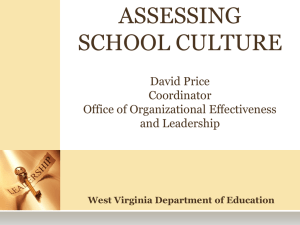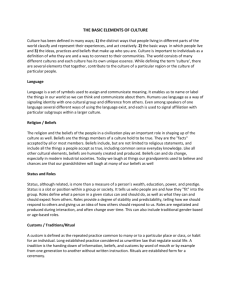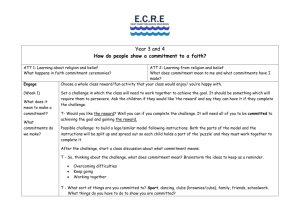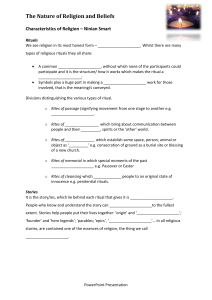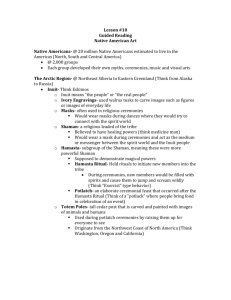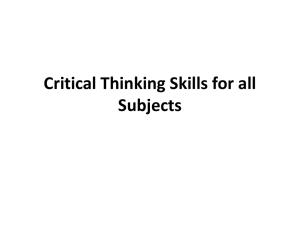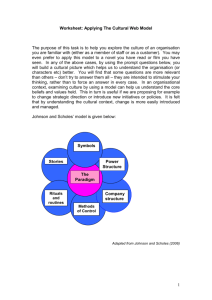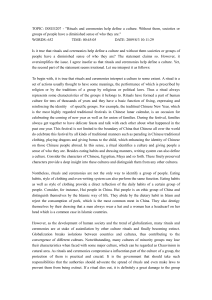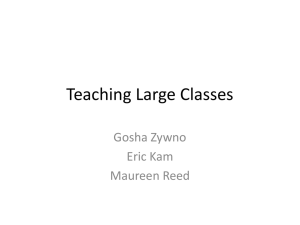Principal as Culture Builder
advertisement
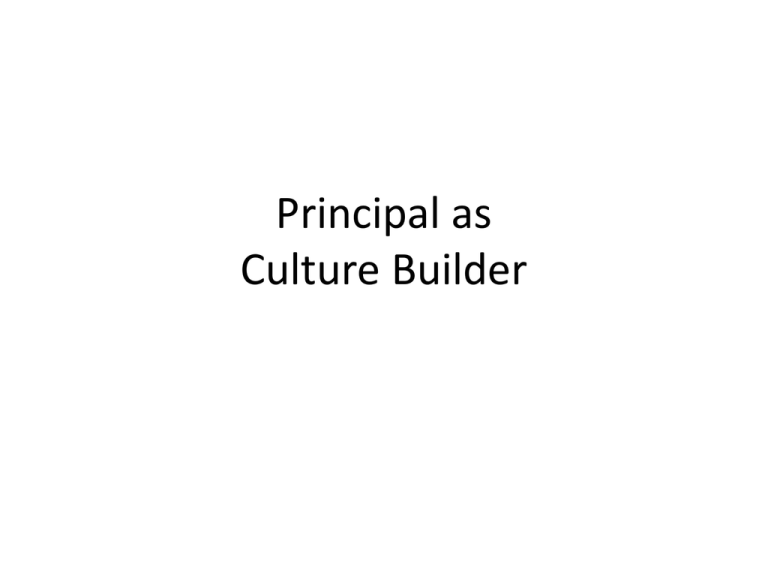
Principal as Culture Builder A Cultural Perspective for Learning in Community • Defining School Culture Schein’s Cultural Elements • Historical and current artifacts (including behavior norms, traditions, and myths) • Commonly held values and beliefs among internal and external participants in the organization • Basic assumptions that provide the underlying basis for actions, values, and beliefs by the participants Understanding A School’s Existing Culture 1. How long has the school existed? 2. Why was it built, and who were the first inhabitants? 3. Who had a major influence on the school’s direction? 4. What critical incidents occurred in the past, and how were they resolved, if at all? Understanding A School’s Existing Culture cont. 5. What were the preceding principals, teachers, and students like? 6. What does the school’s architecture convey? How is space arranged and used? 7. What subcultures exist inside and outside the school? 8. Who are the recognized (and unrecognized heroes and villains of the school? Understanding A School’s Existing Culture cont. 9. What do people say (and think) when asked what the school stands for? What would they miss if they left? 10. What events are assigned special importance? 11.How is conflict typically defined? How is it handled? Understanding A School’s Existing Culture cont. 12. What are the key ceremonies and stories of the school? 13. What do people wish for? Are there patterns to their individual dreams? Wagner’s three cultural elements that relate specifically to the overall culture of the school • Professional collaboration • Affiliative and collegial relationships • Efficacy or self-determination Questions to link the understanding of the school’s culture with your role as a leader: • What do students, staff, and community members say (and think) when asked what the school stands for? • How do the key people in the school use personal pronouns in describing the school? Characteristics of a Toxic Culture 1. Focused on negative values 2. Fragmented—meaning is derived from subculture membership, antistudent sentiments, or life outside work 3. Almost exclusively destructive 4. Spiritually fractured Negative Roles • • • • • • • • Saboteurs Pessimistic storytellers Keepers of the nightmare Negaholics Prima donnas Space cadets Martyrs deadwood Outcomes of Strong School Cultures Principal Leadership in Creating, Maintaining, and Changing Culture Creating School Culture The first set, primary embedding mechanisms: 1. What leaders pay attention to, measure, and control on a regular basis 2. How leaders react to critical incidents and organizational crisis 3. Observed criteria by which leaders allocate scare resources The first set, primary embedding mechanisms cont. 4. Deliberate role modeling, teaching, and coaching 5. Observed criteria by which leaders allocate rewards and status 6. Observed criteria by which leaders recruit, select, promote, retire, and excommunicate organizational members A second set of mechanisms acts as culture reinforcers 1. 2. 3. 4. 5. Organizational design and structure Organizational systems and procedures Organizational rites and rituals Design of physical space, facades, and buildings Stories, legends, and myths about people and events 6. Formal statements of organizational philosophy, values, and creed Maintaining School Culture • Internal veterans • Internal newcomers • External constituents Changing School Culture: Seven steps in responding to toxic cultures 1. Confront the negativity head on; give people a chance to vent their venom in a public forum 2. Shield and support positive cultural elements and staff 3. Focus energy on the recruitment, selection, and retention of effective, positive staff 4. Rabidly celebrate the positive and the possible 5. Consciously and directly focus on eradicating the negative and rebuilding around positive norms and beliefs 6. Develop new stories of success, renewal, and accomplishment 7. Help those who might succeed and thrive in a new district make the move to a new school The Principal Facilitating Others in Understanding and Developing Culture 1. 2. 3. 4. 5. 6. Visionary Symbol Potter Poet Actor Healer Five Possibilities that Symbolize what Principals and Assistant Principals can do 1. Symbolize core values in the way offices and classrooms are arranged 2. Model values through the leader’s demeanor and actions 3. Use time to communicate what is important, what should be attended to 4. Realize that what is appreciated, recognized, and honored signals the key values of what is admirable and achievable 5. Recognize that official correspondence is a visible measure of values and reinforces the importance of that is being disseminated Four Ways to Shape the Culture 1. They infuse shared values and beliefs into every aspect of the culture 2. They anoint heroes and heroines, anointing and recognizing the best role models in the school 3. They observe rituals as a means of building and maintaining esprit de corps 4. They perpetuate meaningful, value-laden traditions and ceremonies Three Examples of Ways Teacher Leaders can Work with Principles in Reinforcing Positive Aspects of Culture: • Celebrate successes in staff meetings and ceremonies • Tell stories of accomplishment and collaboration whenever they have the opportunity • Use clear, shared language created during professional development to foster commitment to staff and student learning
